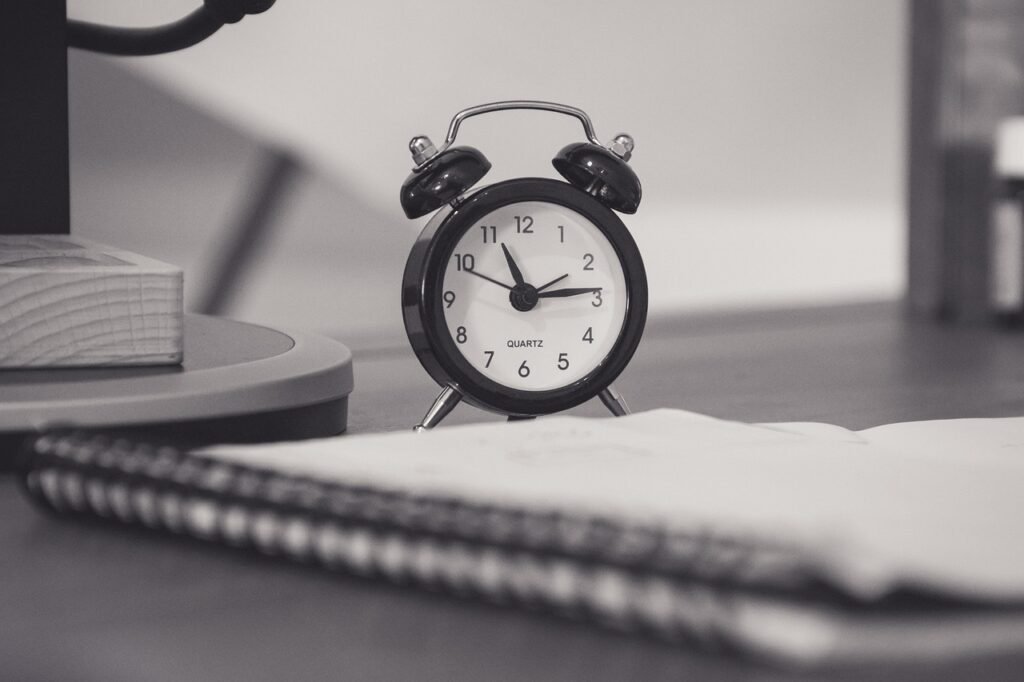
Have you ever wondered why your productivity varies throughout the day? One moment you’re breezing through tasks, and the next, you struggle to stay focused. This has to do with our body’s biological clock and our ability to concentrate. Understanding and harnessing these factors can optimize your work schedule for peak performance. Let’s delve deeper and unravel how to identify your optimal work hours.
Understanding Your Biological Clock

Your biological clock, or circadian rhythm as the scientists call it, is like a master conductor orchestrating a symphony within your body. It is this clock that signals when to sleep, when to wake, and when to eat, dictating our behavioral patterns and physiological activities over a 24-hour cycle. Imagine it as a wave, flowing from peaks of alertness to troughs of drowsiness, regulating not just your sleep-wake cycle, but also the release of hormones, your body temperature, and even your digestion.
But what’s particularly intriguing is how your circadian rhythm shapes your mental alertness and focus. At certain times of the day, the maestro signals your brain to be on high alert, priming you for deep focus and high productivity. At other times, the rhythm dips, indicating it’s time to rest, recharge, or engage in less demanding tasks.
In essence, your biological clock holds the secret to identifying your best work hours. This doesn’t mean that everyone’s peak alertness or productivity times are the same. Quite the contrary, each person’s circadian rhythm is unique, shaped by factors such as age, lifestyle, and even genetics.
Ever noticed how some people are bright-eyed and bushy-tailed in the early morning, ready to conquer the world before breakfast, while others are night owls, finding their most creative sparks under the cover of darkness? This is due to differences in what scientists refer to as ‘chronotypes’, which determine whether you’re a morning lark, a night owl, or somewhere in between.
Getting in tune with your biological clock and understanding its rhythm can be a game-changer. It means working in sync with your body’s natural rhythm rather than against it, setting yourself up for enhanced focus, higher productivity, and overall improved work-life balance.
So, as you journey on the road to mastering your schedule, your biological clock is your trusted guide, lighting the way to your optimal work hours. But the key is to listen to its rhythms, respect its cues, and most importantly, embrace your unique chronotype. In the next section, we will explore the science of concentration and how it fluctuates throughout the day. Stay tuned!
The Science of Concentration

Just like the rhythm of a catchy tune, our ability to concentrate ebbs and flows throughout the day. But what is concentration, really? In essence, it’s the capacity to direct our cognitive resources toward a specific task or thought, filtering out the background noise of irrelevant stimuli. It’s a crucial skill, particularly in our information-saturated era, where distractions are merely a mouse-click away.
However, as you may have noticed, not all hours are created equal when it comes to our ability to concentrate. Have you ever tried to solve a complex problem late at night or read an intricate report just after waking up? Chances are it felt like wading through a mental fog. On the other hand, there are periods in the day when focus seems to flow effortlessly, as if we’ve found the ‘zone.’
So, what’s going on here? This rhythm of concentration is primarily driven by our biological clock, as we discussed earlier. But there’s more to it. Another vital player is our brain’s energy supply, primarily glucose and oxygen, which fluctuate in availability throughout the day.
During periods of wakefulness, our brains are voracious energy consumers, gobbling up about 20% of the body’s total energy resources, despite representing only 2% of the body’s weight. This energy fuels all brain activity, including concentration. As our energy levels rise and fall, so does our ability to concentrate. Therefore, those times of day when our energy levels are peaking often align with when our concentration is at its sharpest.
Another factor at play is the interplay of neurotransmitters in our brains, particularly dopamine and norepinephrine. These chemicals play pivotal roles in promoting alertness, motivation, and, you guessed it, concentration. Their levels rise and fall in sync with our circadian rhythm, further influencing our mental sharpness throughout the day.
Finally, psychological factors such as motivation, mood, and stress levels can also impact our ability to focus. These can vary significantly throughout the day and from one day to the next, adding another layer of complexity to our concentration rhythm.
Understanding the science behind concentration provides a better appreciation of its ebb and flow. It’s not just about willpower or discipline. Biological, biochemical, and psychological factors are all playing their part in this mental symphony. By acknowledging these factors and their influence, we are better equipped to identify our peak concentration periods and align our most demanding tasks accordingly. So, let’s delve into that next!
Identifying Your Peak Concentration Times

Armed with the knowledge of your biological clock and the science of concentration, the next logical step is finding your peak concentration times. But, how do you tap into your body’s rhythm and unearth these coveted hours of heightened focus? It’s not as daunting as it may sound.
Start by observing your energy levels throughout the day for a week or so. Keep a simple log, jotting down times when you felt particularly alert and when you felt more sluggish. Don’t limit your observations to your work hours only. Consider the entire span of your day. When did you feel most awake? When did your energy dip? You might find patterns emerging that could provide insights into your unique rhythm.
Secondly, take note of the tasks you found easy to accomplish at certain times of the day versus those that seemed more challenging. Did you notice that writing your reports felt like a breeze in the early morning but a slog in the late afternoon? Or perhaps brainstorming for new ideas came naturally in the evening but felt like a Herculean task in the morning. Make a record of these observations, and you’ll start to notice patterns that hint at your peak concentration times.
Next, you could also consider using self-assessment tools or quizzes available online that are designed to determine your chronotype. These tests can provide valuable insights into your natural sleep-wake cycle and the likely times for your peak and trough periods of alertness.
Another approach to pinpoint your optimal work hours involves manipulating your environment. You could experiment with working in different settings or at different times and gauge how it impacts your concentration. For instance, if you’ve always been a morning person, try working at night for a few days and see how your focus fares. Or if you usually work in a bustling cafe, try a quiet library or a serene park. The contrast could reveal surprising facts about your peak productivity periods.
Remember, it’s crucial not to let preconceived notions or societal norms dictate your peak work hours. Just because the conventional 9-to-5 schedule is the norm doesn’t mean it’s the best fit for you. Embrace your unique rhythm, even if it differs from societal expectations or your peers’ schedules.
Also, don’t forget to consider other lifestyle factors that could impact your concentration, such as your diet, exercise routine, and sleep habits. For example, if you’re not getting enough quality sleep, your concentration levels could suffer, regardless of your chronotype or energy patterns.
Finally, it’s important to note that identifying your peak concentration times is not a one-time task. As we age, our biological clock shifts, and with it, our peak productivity periods may also change. Regular self-assessment and adaptation are key to staying in tune with your optimal work hours.
In the end, understanding and aligning your work schedule with your peak concentration times is all about self-awareness. By tuning into your body’s natural rhythm and respecting its cues, you can optimize your productivity, enhance your work-life balance, and create a work schedule that works for you!
Balancing Your Work Schedule

You’ve decoded your biological clock and tapped into the science of concentration. Now, you’re ready to engineer your schedule to align with your peak productivity hours. Here’s how you do it.
Start by scheduling your most critical tasks during your prime focus periods. If you’ve noticed that you’re sharpest in the morning, use this time to tackle your most demanding tasks. Conversely, if you’ve identified yourself as a night owl, schedule your deep work for the evening hours. Remember, this is all about using your energy where it counts the most.
Next, use your less optimal hours for routine or less challenging tasks. These could be administrative tasks, emails, or meetings. These tasks usually require less focus and can therefore be scheduled during your lower energy periods.
Another strategy is to take frequent breaks throughout the day to keep your mind fresh. The Pomodoro Technique is a popular method where you work for a set period (typically 25 minutes), then take a short break (typically 5 minutes). This rhythm helps to sustain your focus and stave off mental fatigue.
Consider integrating physical activity into your day. Regular exercise can boost your energy levels, enhance your mood, and improve your cognitive function. If you notice a slump in your energy in the afternoon, a short walk or a quick workout can re-energize you for the rest of the day.
Remember to nurture good sleep habits. Your biological clock is heavily influenced by your sleep cycle. Ensuring you get sufficient quality sleep is crucial for maintaining your circadian rhythm and consequently, your focus during the day. Establish a consistent sleep schedule and create a conducive sleep environment to promote restful sleep.
Don’t forget to factor in time for rest and relaxation. All work and no play is a recipe for burnout. Be sure to schedule downtime into your day to rest, recharge, and allow for creativity to flow. This could be quiet time for reading, practicing a hobby, or spending time with loved ones.
Finally, be flexible. Life happens, and there will be days when your energy levels fluctuate or distractions abound. Listen to your body and adjust your schedule as necessary. If you’re feeling particularly energetic one evening, use that time to get ahead on a project. If you’re feeling drained, allow yourself time to rest and recharge.
Balancing your work schedule is not a one-size-fits-all approach, and what works for one person may not work for another. The key is to listen to your body, understand your peak concentration times, and craft a schedule that respects your unique rhythm.
Ultimately, balancing your work schedule is an ongoing process, requiring continuous self-assessment and adjustment. But by tuning into your body’s natural rhythm, you’re equipping yourself with a powerful tool to enhance your productivity, boost your performance, and improve your work-life balance. And remember, it’s not about working longer hours; it’s about working smarter hours. With these strategies, you’re well on your way to mastering your schedule and making your work hours work for you!
